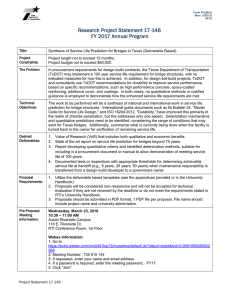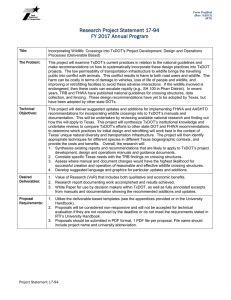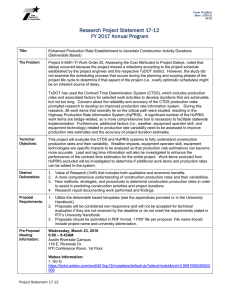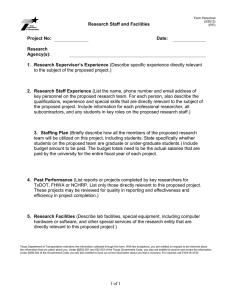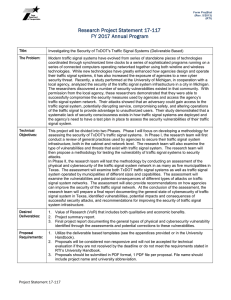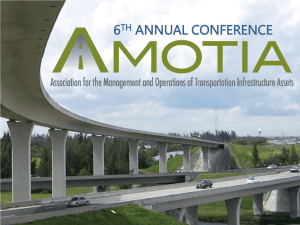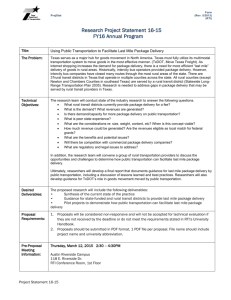PROJECT SUMMARY 0-6735: Best Practices for TxDOT on Handling Wildfires Background
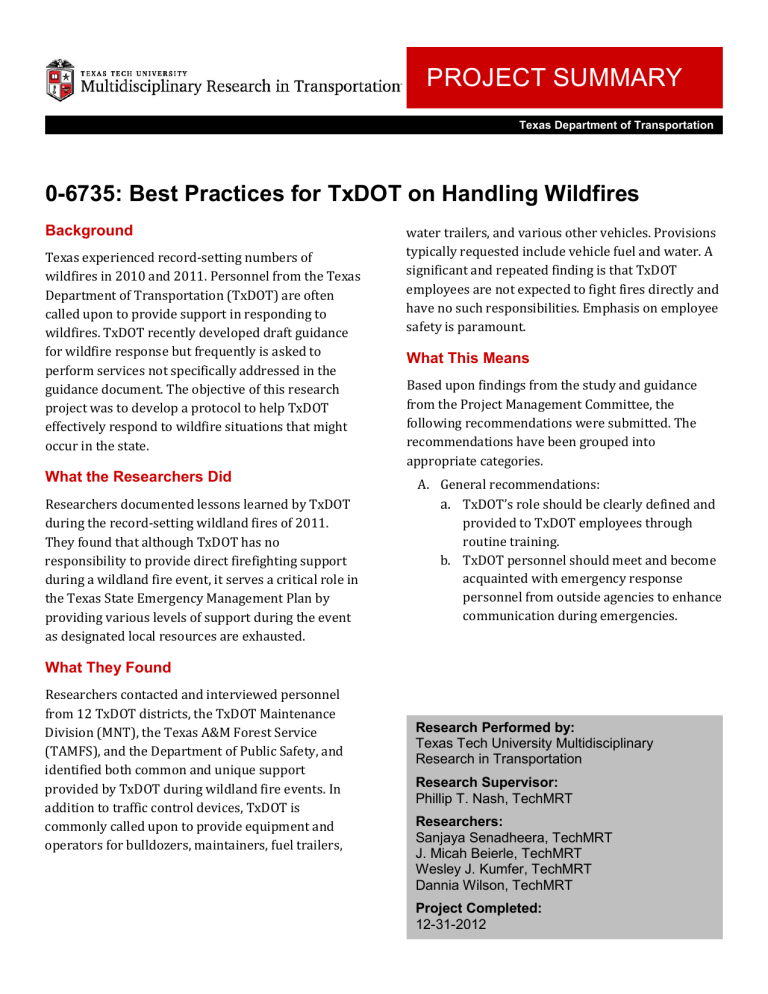
PROJECT SUMMARY
Texas Department of Transportation
0-6735: Best Practices for TxDOT on Handling Wildfires
Background
Texas experienced record-setting numbers of wildfires in 2010 and 2011. Personnel from the Texas
Department of Transportation (TxDOT) are often called upon to provide support in responding to wildfires. TxDOT recently developed draft guidance for wildfire response but frequently is asked to perform services not specifically addressed in the guidance document. The objective of this research project was to develop a protocol to help TxDOT effectively respond to wildfire situations that might occur in the state.
What the Researchers Did
Researchers documented lessons learned by TxDOT during the record-setting wildland fires of 2011.
They found that although TxDOT has no responsibility to provide direct firefighting support during a wildland fire event, it serves a critical role in the Texas State Emergency Management Plan by providing various levels of support during the event as designated local resources are exhausted. water trailers, and various other vehicles. Provisions typically requested include vehicle fuel and water. A significant and repeated finding is that TxDOT employees are not expected to fight fires directly and have no such responsibilities. Emphasis on employee safety is paramount.
What This Means
Based upon findings from the study and guidance from the Project Management Committee, the following recommendations were submitted. The recommendations have been grouped into appropriate categories.
A.
General recommendations: a.
TxDOT’s role should be clearly defined and provided to TxDOT employees through routine training.
b.
TxDOT personnel should meet and become acquainted with emergency response personnel from outside agencies to enhance communication during emergencies.
What They Found
Researchers contacted and interviewed personnel from 12 TxDOT districts, the TxDOT Maintenance
Division (MNT), the Texas A&M Forest Service
(TAMFS), and the Department of Public Safety, and identified both common and unique support provided by TxDOT during wildland fire events. In addition to traffic control devices, TxDOT is commonly called upon to provide equipment and operators for bulldozers, maintainers, fuel trailers,
Research Performed by:
Texas Tech University Multidisciplinary
Research in Transportation
Research Supervisor:
Phillip T. Nash, TechMRT
Researchers:
Sanjaya Senadheera, TechMRT
J. Micah Beierle, TechMRT
Wesley J. Kumfer, TechMRT
Dannia Wilson, TechMRT
Project Completed:
12-31-2012
c.
Good communication channels are extremely important during wildland fire response and should be clearly identified within TxDOT. d.
Updated county topographic, utility, pipeline, and road maps should be made available.
B.
Notification/request for district assistance during a wildland fire event: a.
Emphasize that the TxDOT district
Director of Maintenance (DOM) is the focal point for district wildland fire response activities. b.
Formalize procedure for notifying districts of Governor’s and Presidential
Proclamations.
C.
Communication related to a wildland fire event within TxDOT: a.
Prepare to use Compass MMS to: i.
Record data on TxDOT resource utilization during wildland fire response. ii.
Generate reports for reimbursement requests. b.
Establish advanced briefing and debriefing practices.
D.
Communication with outside agencies: a.
Clarify lines of communication with outside agencies. b.
The DOM is the district point of contact with outside agencies for wildland fire response.
E.
TxDOT resource utilization during wildland fire events: a.
Establish clear guidelines on providing and record keeping of fuel to vehicles involved in wildland fire response. b.
Refer to Emergency Fueling Guidelines published by MNT. c.
Refer to HR Manual § 2 Chapter 10 for the policy on leave for volunteer firefighters.
d.
Emphasize effective collection and recording of information to enable timely filing for reimbursement.
F.
TxDOT responsibilities to ensure employee and public safety: a.
TxDOT employees are not firefighters and should stay out of harm’s way. b.
The supervisor should monitor weather conditions during a wildland fire event to alert employees. c.
Have access to standard fire-protection equipment (Nomex suits, etc.).
G.
Advanced preparation, readiness, and training: a.
Keep equipment preloaded, positioned, and ready for deployment whenever possible. b.
Monitor weather reports and TFS notifications.
H.
Existing resources/guidance from TxDOT and other agencies: a.
Update guidance document. b.
Take advantage of training opportunities from TAMFS and other agencies. c.
One emergency response manual including a section on wildland fire response is preferred. d.
Develop standard practice checklists for the DOM and Maintenance Supervisor .
For More Information
Project Manager:
Wade Odell, TxDOT, (512) 416-4737
Research Supervisor:
Phillip T. Nash, TechMRT, (806) 742-3523
Technical reports when published are available at http://library.ctr.utexas.edu.
Research and Technology Implementation Office
Texas Department of Transportation
125 E. 11th Street
Austin, TX 78701-2483 www.txdot.gov
Keyword: Research
This research was performed in cooperation with the Texas Department of Transportation and the Federal Highway Administration. The contents of this report reflect the views of the authors, who are responsible for the facts and accuracy of the data presented here. The contents do not necessarily reflect the official view or policies of FHWA or TxDOT. This report does not constitute a standard, specification, or regulation, nor is it intended for construction, bidding, or permit purposes. Trade names were used solely for information and not for product endorsement.
